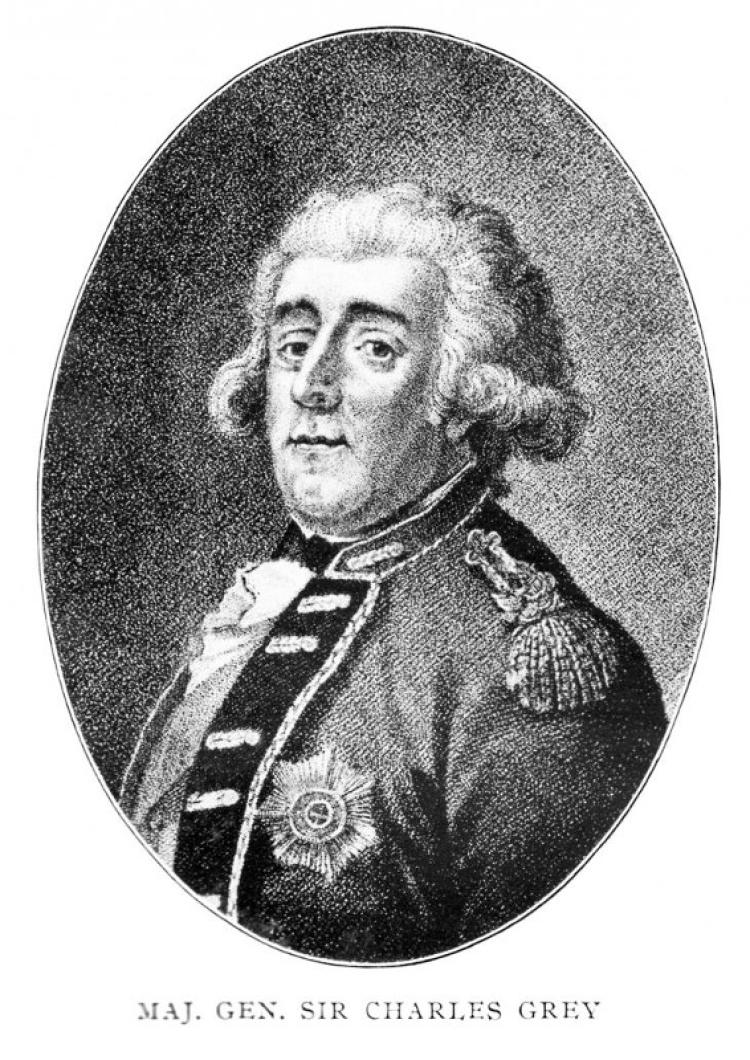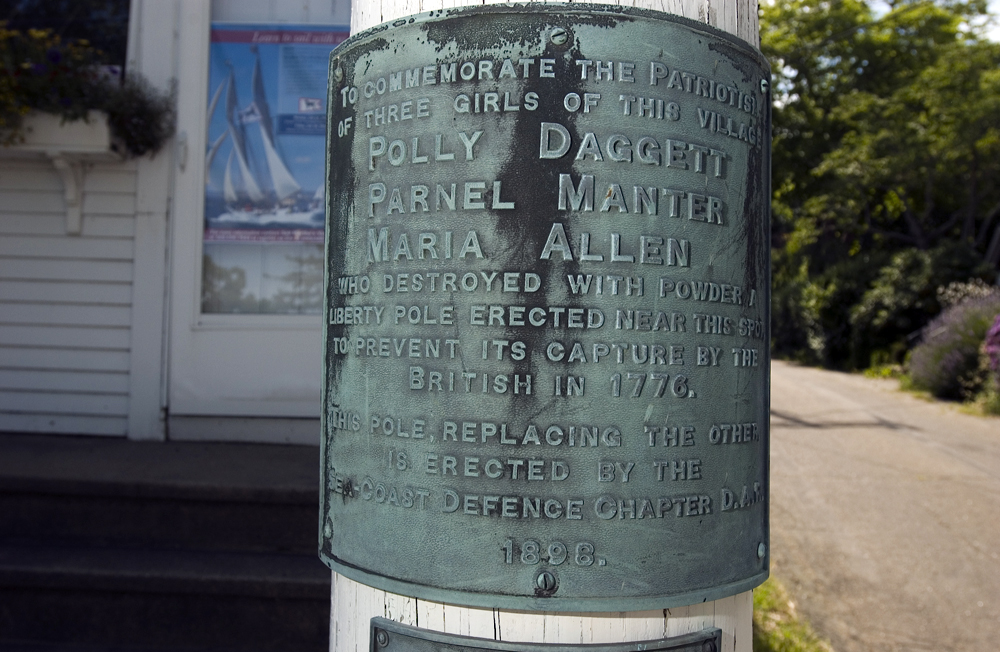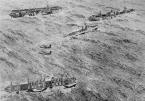Martha’s Vineyard endured a precarious existence in those heady days of the young republic. As the founding fathers debated the philosophical underpinnings of liberal democracy in Philadelphia, entire British and Hessian fleets skulked just over our horizon (as reported by contemporary whalers). The vulnerable and largely defenseless Island was caught in limbo and few natives ventured to offend the Crown. As the war drew on, though, and these specters increasingly emerged in Vineyard harbors to exact their punishing toll, Islanders became patriots.
The most infamous and humiliating chapter in Vineyard history occurred on Sept. 11, 1778, the terrible Grey’s Raid, when ruthless British Maj. Gen. Charles Grey unleashed the full brunt of British Naval intimidation on the beleaguered Island with nearly 40 ships and over 4,000 troops. It was a bloodless pillage but a pillage nonetheless, as Islanders were forced to march 10,574 sheep, 315 cattle, innumerable bales of hay and 229 arms to present-day Vineyard Haven. Unsatisfied with these ill-gotten spoils, Grey’s men then scoured the countryside, looting house and field.
“Even so Curious were they in searching as to Disturb the ashes of the dead,” wrote James Otis of Falmouth. “Many houses were all Riffled and their Windows were all broke.”
In Vineyard Haven dozens of ships and two saltworks were destroyed before the British pushed off on Sept. 14. It was not, however, the Island’s first encounter with the British, although it did seal Vineyard sentiments against the occupying force.
Early in the Revolution Island attitudes were at least neutral if not favorable toward the Crown. The Islanders’ unmatched whaling skills were prized by the British, as they watched lucrative profits return to England. As such, the Vineyard enjoyed an administration of benevolent neglect from abroad. As early as 1775, however, as the British began closing nearby ports and occasionally coming ashore to requisition livestock, Islanders hardened their hearts towards the lobsterbacks.
Two distinguished Edgartown leaders, Peter Norton and William Jernegan (himself a veteran of the French and Indian War), drafted a non-importation agreement in 1775 binding fellow citizens to the revolutionary cause:
“We the subscribers Inhabitants of the Town of Edgartown Do Sincerely and Truly Covenant and agree . . . that We Will not Directly nor indirectly . . . Purchase of . . . any Kind of Goods Wares or Merchandizes of the Growth produce or manufacture of Great Britain or of the East Indies Imported from Great Britain . . . until our Charter Rites be Restoered and the Port of Boston Be opened: and if any Person or Persons Belonging to said Town Shall Refuse to Sign this or a Similar agreement . . . We Will Deem them Enemies of the Country and Supporters of the Oppressive Acts of the British Parliament.”
However, other Islanders were not so compelled by the fledgling patriotic fervor, as Joseph Mayhew recorded in a letter to Boston:
“The real state of things here as I apprehend, is this. There are some here who are really not well affected to the present Government, nor to the measures now pursued in Defence of our civil liberties, and these ill affected Persons endeavour to embarrass the establishing of Civil Government in this County: and through their suggestions (in part at least) many persons here, perhaps near one half the People of this County, imagine it is best for us considering our situation to be still and in no way shew ourselves to be on the side of the Assertors of our civil liberties lest we hereby provoke the Invaders of our Coasts to ruin us . . .”
Vineyarders were not unjustified in fearing such reprisals. Records of British plunder abound from the period, from British troops harassing a humble Naushon innkeeper to the learned habit of locals in marching their livestock several miles inland to avoid their mysterious disappearance. In addition the Island was virtually powerless to defend itself, as many of those of fighting age and persuasion had already gone off to join the Continental Army. At least two Vineyarders, Joseph Huxford of Edgartown and Malachi Baxter of Tisbury, fought at Bunker Hill.
Of course no act of British rapine went without a flourish of foppish gentility. Responding to a plea from Tisbury selectmen to relent in their constant threats of violence on the townspeople for livestock and produce, Captain Collins of the H.M.S. Nautilus composed this precious reply from his floating quarters in Vineyard Haven harbor:
“Gentlemen: I am . . . sorry for the situation of the times, but when matters are carried so far as to deny a little Milk or a Cabbage to a Single ship, a thing of no small moment it rather tends to Kindle that unhappy difference which as men and Christians we should exert ourselves to allay. Every contrary exertion on my part would be a matter of Necessity, as I should be sorry to injure any man’s property and nothing of that kind will be thought of but hope we shall pass not worse friends than at this Present and am Gentlemen your most h’ble Serv’t.”
Not all conflicts were resolved peacefully, however. In April of 1776 Captain Nathan Smith of Tisbury set off with a ragged band of minutemen from Vineyard Haven and captured the 60-ton British schooner Volante. Unfortunately little record remains of the venturesome raid besides cursory references in the Massachusetts Archives. But other events were more colorfully captured. When an American ship found itself run aground and looted by British privateers in Chilmark, one resident took matters into his own hands, as the Gazette recalled at the turn of the century with the insouciant racism of the time:
“Abner Mayhew, who lived on Squibnocket, descended to the beach with his shotgun loaded with buckshot and opened fire on the redcoats. He managed to conceal himself so well that their return fire did him no harm; while he wounded many it is not known that he actually killed anyone. In the meantime a negro procured a howitzer with which he began to bombard the invaders from the cliff above, and they were finally compelled to draw off without having effected their purpose, but with so many wounded that they must tow one of the barges out. The Englishman was highly incensed at being thus paid back in his own coin and stood off and on all day shelling the coast, but the only damage he did was to a negro whose curiosity led him to the cliff to see what might be doing and who got in the way of an English ball. It has been no uncommon thing in the past to dig up the small cast-iron balls of about three inches in diameter, which came ashore at that time.”
The British were not the only brigands on the high seas however. The record of then 14-year-old Cornelius Marchant laconically testifies to the harrowing exploits of ships leaving local harbors, as well as to the incredible distances such adventures would cover:
“We put for Edgartown harbor to obtain a complement of men and officers: thence in a few days she departed and proceeded on her cruise.
“About the last of April 1777, we arrived at the Islands of Deloss on the coast of Africa, where we destroyed a large storehouse belonging to the English. Also a little lower down the coast captured two ships, one laden with goods, the other with a cargo of slaves which were sent to Marinica where they safely arrived.
“In the same Cruise captured a large brig laden with ivory and dye woods and sent her to the united States, where, within thirty leagues of Halifax we captured the ship John J. Leith, a large transport richly laden with supplies for the British army at New York . . . During this same cruise we captured three ships, two brigs and one schooner, all of which safely arrived at the ports for which we sent them.”
On the home front William Jernegan of Edgartown, in quelling the residual bloodlust leftover from Grey’s Raid the previous year found himself under attack — much to his surprise — from a fellow citizen, as he recalled in his autobiography:
“In the year 1779 a fleet of British ships anchored in our harbour at Edgartown. Some of our people were then anxious to fire on them with their small arms. I used this influence with the people, not to fire on them, if we did we should have our houses burned. At that time they did us but little damage and soon went off with themselves. The next day, after they were gone, John Kindrick, meeting me on the street, said to me, ‘I have a good mind to beat out your brains out.’ I answered him, ‘For what cause or reason have you to beat out my brains out?’ Kindrick said, ‘Damn you, if it hadn’t been for you I could have had my house burned and then I could have had more than a thousand dollars for it, and now I can not get five hundred dollars for it, and I have lost more than five hundred dollars by you.”
While the memory of Grey’s Raid has faded, the independence and isolation of the Island has not. It is a place still very much populated by people, as described in Edgartown’s 1775 petition to the General Court, “very fond of preserving their liberties,” although hopefully it has become less so a place for people as easily inclined to “beat out” each other’s brains.







Comments (1)
Comments
Comment policy »